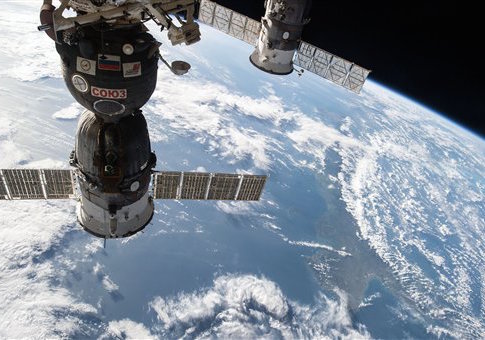The Air Force is watching an out-of-control Russian satellite tumbling toward earth that could reenter the atmosphere with some 3,000 pounds of toxic fuel within two weeks.
An Air Force center in charge of monitoring space threats at Vandenberg Air Force Base, Calif., said the unmanned Space Station resupply cargo craft known as "Progress-M 27M" was initially determined to be in trouble at 3:04 A.M. on Wednesday.
The Joint Space Operations Center is closely tracking the craft and has set up reporting procedures to alert authorities to its fate.
"Currently, the [center] can confirm that the resupply vehicle is rotating at a rate of 360 degrees every five seconds," Air Force said in a statement.
A private space tracking website shows that Progress’ flight path regularly passes over the northern United States and Canada.
A defense official told the Washington Free Beacon that military commanders are aware of the potential threat posed by spacecraft. However, the official said so far there has been no immediate discussion of plans to shoot the craft down before it enters the atmosphere.
An Air Force Space Command spokesman said the craft is expected to reenter on May 9 at around 1:30 P.M. ET.
Another concern is that some 44 pieces of debris are also moving near the satellite and the upper stage of the rocket body that delivered the craft into orbit. The Air Force said it did not know if the debris is from the rocket body or the vehicle itself.
In Moscow, Igor Komarov director of the Russian space agency, told reporters that the Progress-M 27M spacecraft, launched from the Baikonur cosmodrome in Kazakhstan on Tuesday, is a loss and would not dock with the Space Station. The craft malfunctioned for an unknown reason after reaching orbit, he said.
The resupply craft was carrying food and fuel for astronauts on the orbiting Space Station. Its mission cost $51 million.
Current crew members on the Space Station include Americans Terry Virts and Scott Kelly, Russians Anton Shkaplerov, Gennady Padalka and Mikhail Korniyenko, and Italian Samantha Cristoforetti.
Vladimir Solovyev, flight director for the Russian section of the ISS, said the wreckage of the craft would likely burn upon reentry. The descent trajectory, "indicates that the structural elements of the ship will not reach the earth's surface," he said, Reuters reported.
Space analysts said the reentry of fully-fueled craft could pose a danger, if the fuel freezes. Some of the frozen fuel likely would survive the high-speed burn up of the craft as it reenters the atmosphere and potentially land on populated areas.
"The Progress is carrying up to three times the amount of toxic propellants as did USA-193 when it was deemed sufficiently hazardous to require active remediation [in 2008]," said James Oberg, a space affairs analyst.
"There could be a ton and a half of toxic chemicals on board, something we don't like falling at random out of the sky because the cold or frozen fluids greatly enhance the chance of getting the fuel down to the ground."
Oberg said for decades spacecraft the size of the Progress — even without toxic chemicals — were deliberately steered into open ocean to minimize the risk of endangering populated areas "because relying on dumb luck was deemed too dangerous."
"The hazard rationale for shattering USA-193 was authentic, numerous independent expert panels confirmed the danger from its hydrazine was the most dangerous incoming satellite in history," he said.
During 2008 incident, the Pentagon modified and fired a Navy SM-3 anti-missile interceptor at the falling satellite.
The outcome was widely viewed as a demonstration of U.S. anti-satellite missile capabilities. It took place several months after China’s January 2007 test of an anti-satellite missile that destroyed a weather satellite and created some 3,000 pieces of floating debris.
"Human spaceflight safety is our chief concern," said Lt. Gen. Jay Raymond, commander of the JFCC Space and 14th Air Force (Air Forces Strategic) Commander. "We will continue to monitor the situation and work with our government, international, and industry partners to ensure the safety of the astronauts onboard the ISS and provide for the long-term safety, sustainability, security, and stability of the space domain."
The Air Force said questions about the cargo graph and attempts to reestablish command should be directed to Russian flight controllers.
The 2008 operation to destroy the NRO satellite used the anti-satellite missile to target the fuel tanks on the spacecraft and dissipate is load of 1,000 pounds of hydrazine fuel that U.S. officials said posed a danger to people on land.
The modified SM-3 missile was launched Feb. 21, 2008, from a Navy missile cruiser and hit the satellite before reentry, some 153 miles above the Pacific Ocean.
The satellite was traveling at around 17,500 miles per hour. The debris from the satellite burned up in the atmosphere.
Update 10:43 A.M.: This post has been updated with additional information from an interview with James Oberg, a space affairs analyst.
